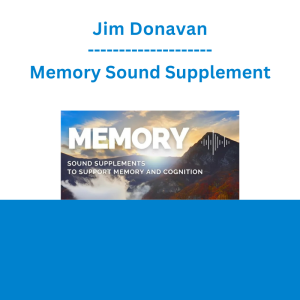*** Proof of Product ***
Exploring the Essential Features of “Fall Risk and Functional Impairments: Using Standardized Tests to Guide Treatment – Rachel Blackwood”
Description
Therapists and other healthcare practitioners have an increasingly complex role in discharge planning from acute care as hospital stays become shorter and 30 day readmission rates are more closely scrutinized. It is imperative that acute care therapists not only identify but also be able to quantify functional impairments and fall risk. Standardized testing in hospitals is complicated by the frailty of the patient population, management of multiple lines and medical issues, as well as time constraints.
This course is designed to help healthcare practitioners by familiarizing them with the variety of tests to choose from, and to assist them in making sense of test outcomes. You will learn and practice tests that can be used on patients with high levels of mobility, as well as those tests that are appropriate for the ICU. During this lab-intensive course, you will be introduced to an array of objective measures that can be used to enhance assessments and documentation, to guide treatment, and to aid in discharge planning.
Speaker
Rachel Blackwood, PT, DPT, is a licensed physical therapist with nearly 15 years of experience. She graduated from the University of Alabama at Birmingham with her M.S. in Physical Therapy, then went on to earn her Doctorate of Physical Therapy from the University of South Alabama. Although she has experience in a variety of settings, the majority of her career has been in acute care. She has been involved in program development, staff training, and clinical education. Ms. Blackwood has also served as adjunct faculty at the Jefferson State LPTA program. Her interests include acute and medically complex patients and she has been a team leader in critical care units. She is currently employed by Duke University Health Systems in Raleigh, NC as a weekend therapist. As a weekend PT, she encounters many patients who are “discharge issues”, where her use of standardized tests is a critical consideration for recommending the appropriate discharge placement.
Speaker Disclosures:
Financial: Rachel Ross Blackwood has an employment relationship with Duke Health Services. She receives a speaking honorarium from PESI, Inc. She has no relevant financial relationships with ineligible organizations.
Non-financial: Rachel Ross Blackwood has no relevant non-financial relationships.
Objectives
- Examine barriers with using standardized tests and how to avoid them
- Demonstrate evidence based tests that are applicable in the acute care setting
- Compose appropriate documentation with quantifiable, objective measures
- Determine how standardized tests can be used in the ICU and with other medically complex patients
- Discover how using standardized testing can guide discharge planning and reduce the risk of 30 day readmissions
Outline
BACKGROUND INFORMATION
- Functional impairments relate to 30 day readmission risk
- Barriers preventing standardized testing in acute care
Time constraints
Infection control issues
Multiple lines/ICU patients
Unsure which test is most appropriate - Benefit of adding standardized tests into electronic chart
PSYCHOMETRICS- A REVIEW OF TERMS
- Floor and ceiling effects
- Responsiveness
- Interpreting results
- Translating results into meaningful assessment
FUNCTIONAL IMPAIRMENT TESTS
- 6 clicks- Activity Measure for Post-Acute Care Inpatient Short Form
- Acute Care Index of Function
GAIT: WHEN DOCUMENTING DISTANCE AND LEVEL OF ASSIST ISN’T ENOUGH
- Importance of standardized gait tests
- Gait velocity- a new vital sign?
- Standardized gait tests
2, 3, and 6 minute walk tests
10 meter/50 foot walk test
Dynamic Gait Index
Four Step Square Test - Gait tests and productivity standards
- Case study and lab ICON—BOTH SIDE BY SIDE
BALANCE TESTS
- Quantifying fall risk
- Standardized balance tests, including those taking LESS than 2 minutes to perform
BESTest/mini-BESTest
360 Turn Test
Function in Sitting Test
Fullerton Advance Balance Scale - Which test is best
Setting
Patient frailty
Time constraints - Using tests to justify discharge plan
Rehab
SNF
Home health - Case study and lab ICON—BOTH SIDE BY SIDE
BENEFITS OF ICU STANDARDIZED TESTING
- ICU Specific testsI
CU mobility scale
ICU PFIT
PERME ICU mobility - Complications
Frailty
Managing lines/tubes - Case study and lab ICON—BOTH SIDE BY SIDE
ADLS AND STANDARDIZED TESTS
- Insight into ability to perform functional tasks
- Incorporating tests into discharge planning
- Case study and lab ICON—BOTH SIDE BY SIDE
CVA SPECIFIC TESTS
- Justifying further therapy
- Review of specific tests
Action Research Arm Test
Box and Blocks Test
Orpington Prognostic Scale
Postural Assessment Scale for Stroke Patients
Stroke Rehabilitation Assessment of Movement
Target Audience
- Physical Therapists
- Physical Therapists Assistants
- Occupational Therapists
- Occupational Therapy Assistants
- Rehab Nurses
- Rehab Directors
Please see the full list of alternative group-buy courses available here: https://lunacourse.com/shop/










 Matan Feldman - The 13-Week Cash Flow Modeling - Wall Street Prep
Matan Feldman - The 13-Week Cash Flow Modeling - Wall Street Prep  Racing Workshop - Complete Online Package
Racing Workshop - Complete Online Package  Emanuele Bonanni - My Trading Way
Emanuele Bonanni - My Trading Way  SMB - Options Training
SMB - Options Training  Atlas API Training - API 570 Exam Prep Training Course
Atlas API Training - API 570 Exam Prep Training Course  Dave Landry - Stock Selection Course
Dave Landry - Stock Selection Course  Toshko Raychev - Profit System + ITF Assistant
Toshko Raychev - Profit System + ITF Assistant  The Daily Traders – Exclusive Trading Mentorship Group
The Daily Traders – Exclusive Trading Mentorship Group  Simpler Trading - Bruce Marshall - The Options Defense Course
Simpler Trading - Bruce Marshall - The Options Defense Course  Money Miracle - George Angell - Use Other Peoples Money To Make You Rich
Money Miracle - George Angell - Use Other Peoples Money To Make You Rich  Jesse Livermore Trading System - Joe Marwood
Jesse Livermore Trading System - Joe Marwood  Ed Ponsi - Forex Trading
Ed Ponsi - Forex Trading  Sovereign Man Confidential - Renunciation Video
Sovereign Man Confidential - Renunciation Video  Akil Stokes & Jason Graystone - TierOneTrading - Trading Edge 2019
Akil Stokes & Jason Graystone - TierOneTrading - Trading Edge 2019  Michael Mithoefer - Psychedelic-Assisted Therapy In-depth: In-session demonstrations and real-world insight into MDMA & more
Michael Mithoefer - Psychedelic-Assisted Therapy In-depth: In-session demonstrations and real-world insight into MDMA & more  Biochemistry and Molecular Biology: How Life Works - Kevin Ahern
Biochemistry and Molecular Biology: How Life Works - Kevin Ahern  Crypto Dan - The Crypto Investing Blueprint To Financial Freedom By 2025
Crypto Dan - The Crypto Investing Blueprint To Financial Freedom By 2025  Jane Roberts - The Seth MP3 #18 - Digital Download - Seth Center
Jane Roberts - The Seth MP3 #18 - Digital Download - Seth Center  Scott Benedict - COMPREHENDED! 2021
Scott Benedict - COMPREHENDED! 2021  Jim Donavan - Memory Sound Supplement
Jim Donavan - Memory Sound Supplement  Steven Shadow - The Perfect Seduction
Steven Shadow - The Perfect Seduction  Matthew Kratter - Trader University
Matthew Kratter - Trader University  Alphashark - The AlphaShark SV-Scalper
Alphashark - The AlphaShark SV-Scalper  GOATA Movement Blueprint
GOATA Movement Blueprint  Rajandran R - Practical Approach to Amibroker AFL Coding
Rajandran R - Practical Approach to Amibroker AFL Coding  Greg Loehr - Advanced Option Trading With Broken Wing Butterflies
Greg Loehr - Advanced Option Trading With Broken Wing Butterflies  The Geometric Trading Course - Apprentice Level II
The Geometric Trading Course - Apprentice Level II  Maven Analytics, Chris Dutton & Aaron Parry - Microsoft Power BI Desktop for Business Intelligence (2023)
Maven Analytics, Chris Dutton & Aaron Parry - Microsoft Power BI Desktop for Business Intelligence (2023)  Lara Adler - The Certificate Course in Environmental Health
Lara Adler - The Certificate Course in Environmental Health  George Fontanills & Tom Gentile - Optionetics Wealth Without Worry Course
George Fontanills & Tom Gentile - Optionetics Wealth Without Worry Course  Team NFT Money - Ultimate NFT Playbook
Team NFT Money - Ultimate NFT Playbook  David Cavanagh – YouTube Internet Secrets Revealed
David Cavanagh – YouTube Internet Secrets Revealed  Michael Carroll - Close That Sale
Michael Carroll - Close That Sale  Advanced MMXM – The Inner Circle Dragons
Advanced MMXM – The Inner Circle Dragons  Debra Premashakti Alvis - Compassion Fatigue Certification Training for Healthcare, Mental Health and Caring Professionals
Debra Premashakti Alvis - Compassion Fatigue Certification Training for Healthcare, Mental Health and Caring Professionals  Kim Walsh Phillips - Ultimate Facebook Toolkit 2015
Kim Walsh Phillips - Ultimate Facebook Toolkit 2015  Craig Heidemann - FAST CLASS: Legal Survival Guide
Craig Heidemann - FAST CLASS: Legal Survival Guide  Teddy Atlas - Timing - Boxing’s Shot Clock For Success
Teddy Atlas - Timing - Boxing’s Shot Clock For Success  Wondrium - Wondrium Pilots: Black Americans and the Revolutionary War
Wondrium - Wondrium Pilots: Black Americans and the Revolutionary War  Phil Ebiner & Diego Davila & Video School - Digital Marketing Masterclass - 23 Courses in 1
Phil Ebiner & Diego Davila & Video School - Digital Marketing Masterclass - 23 Courses in 1  Craig Heidemann - Accounting for Photographers
Craig Heidemann - Accounting for Photographers  Elaine Aron - Sounds True - The Highly Sensitive Person's Complete Learning Program
Elaine Aron - Sounds True - The Highly Sensitive Person's Complete Learning Program  John James Santangelo - Discovering NLP: Introduction To The Basic Principles Of NLP
John James Santangelo - Discovering NLP: Introduction To The Basic Principles Of NLP  TTC Video – Scientific Secrets for a Powerful Memory
TTC Video – Scientific Secrets for a Powerful Memory  Eckhart Tolle & Kim Eng - Omega Livestream
Eckhart Tolle & Kim Eng - Omega Livestream  Brooke Shaden - Creating Impact in a Dull Space
Brooke Shaden - Creating Impact in a Dull Space  Scott Sonnon - King of Clubs
Scott Sonnon - King of Clubs  Briohny Smith - Power Vinyasa
Briohny Smith - Power Vinyasa  Think Rich Films - Think and Grow Rich: The Legacy Movie
Think Rich Films - Think and Grow Rich: The Legacy Movie  Paul Zaichik - Easy Flexibility - Pistol - One Legged Squat
Paul Zaichik - Easy Flexibility - Pistol - One Legged Squat  Simpler Trading – Futures Freedom Plan (Elite Package)
Simpler Trading – Futures Freedom Plan (Elite Package)  Jon Brosio - Masterclass Bundle
Jon Brosio - Masterclass Bundle  Blake Young - Forex Trading Strategies Modules 1-3 Complete Set - Shadow Trader
Blake Young - Forex Trading Strategies Modules 1-3 Complete Set - Shadow Trader  Making Fashion: Draw Draft and Sew - Jay Calderin
Making Fashion: Draw Draft and Sew - Jay Calderin  Terry Real - CC07 Workshop 01 - Getting to the Heart of It: How to Change Couples Quickly, Dramatically, and Permanently
Terry Real - CC07 Workshop 01 - Getting to the Heart of It: How to Change Couples Quickly, Dramatically, and Permanently  Gene Ang - The Art of Higher Forms of Manifestation
Gene Ang - The Art of Higher Forms of Manifestation  Briefcase Books - The Manager’s Guide to Effective Meetings - Barbara Streibel - McGraw-Hill
Briefcase Books - The Manager’s Guide to Effective Meetings - Barbara Streibel - McGraw-Hill